#Inanna-ishtar
Text
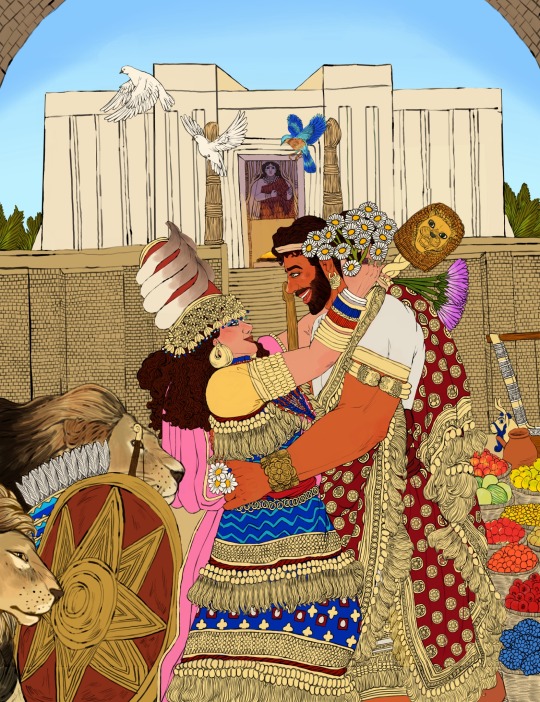

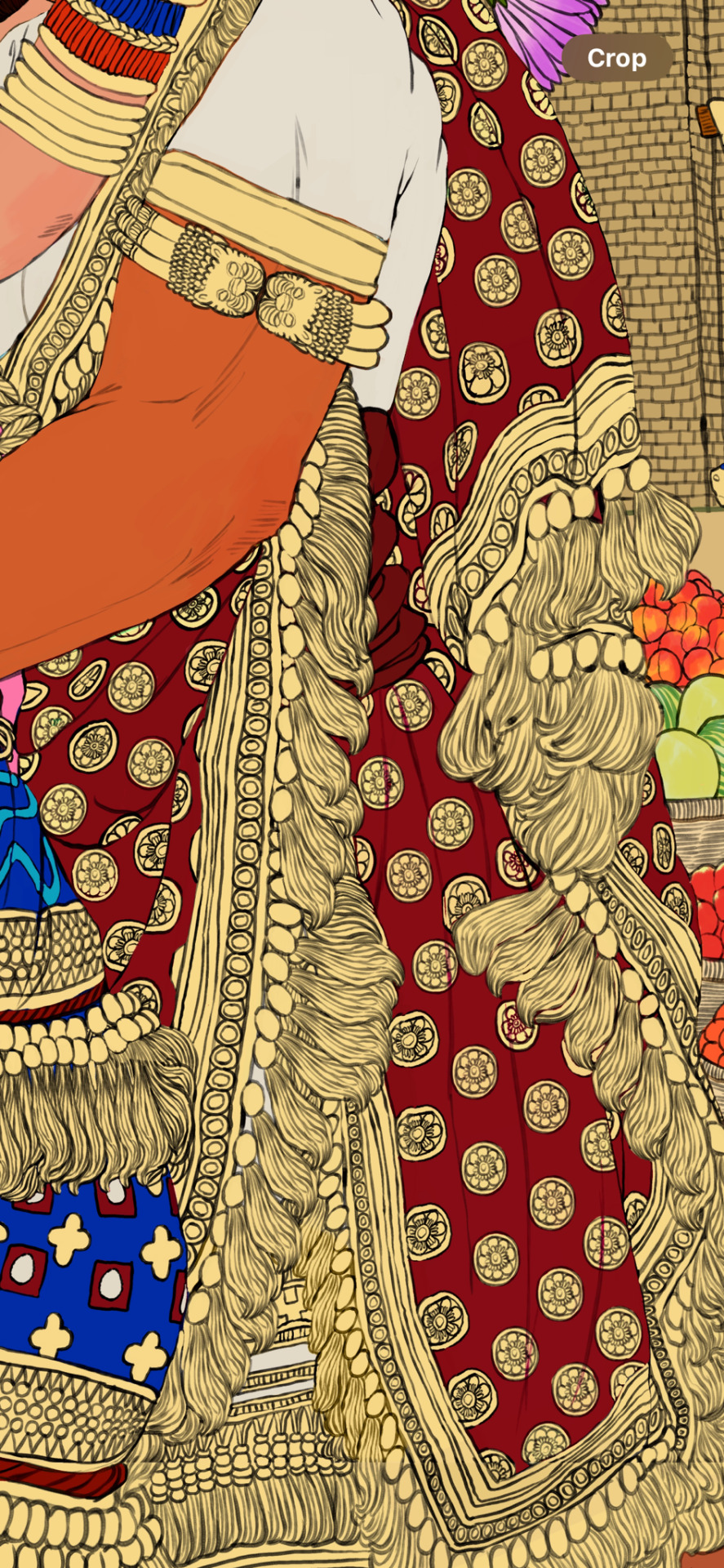

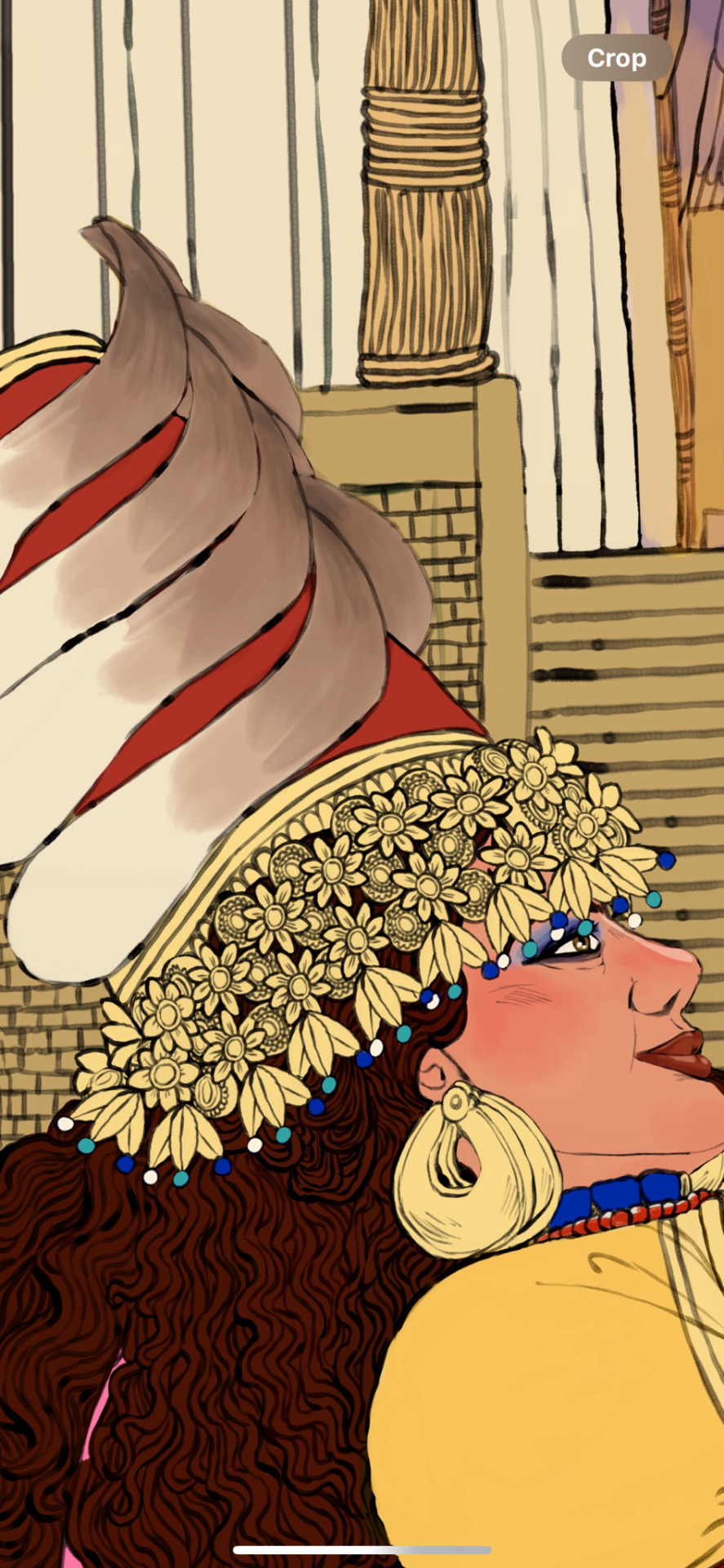
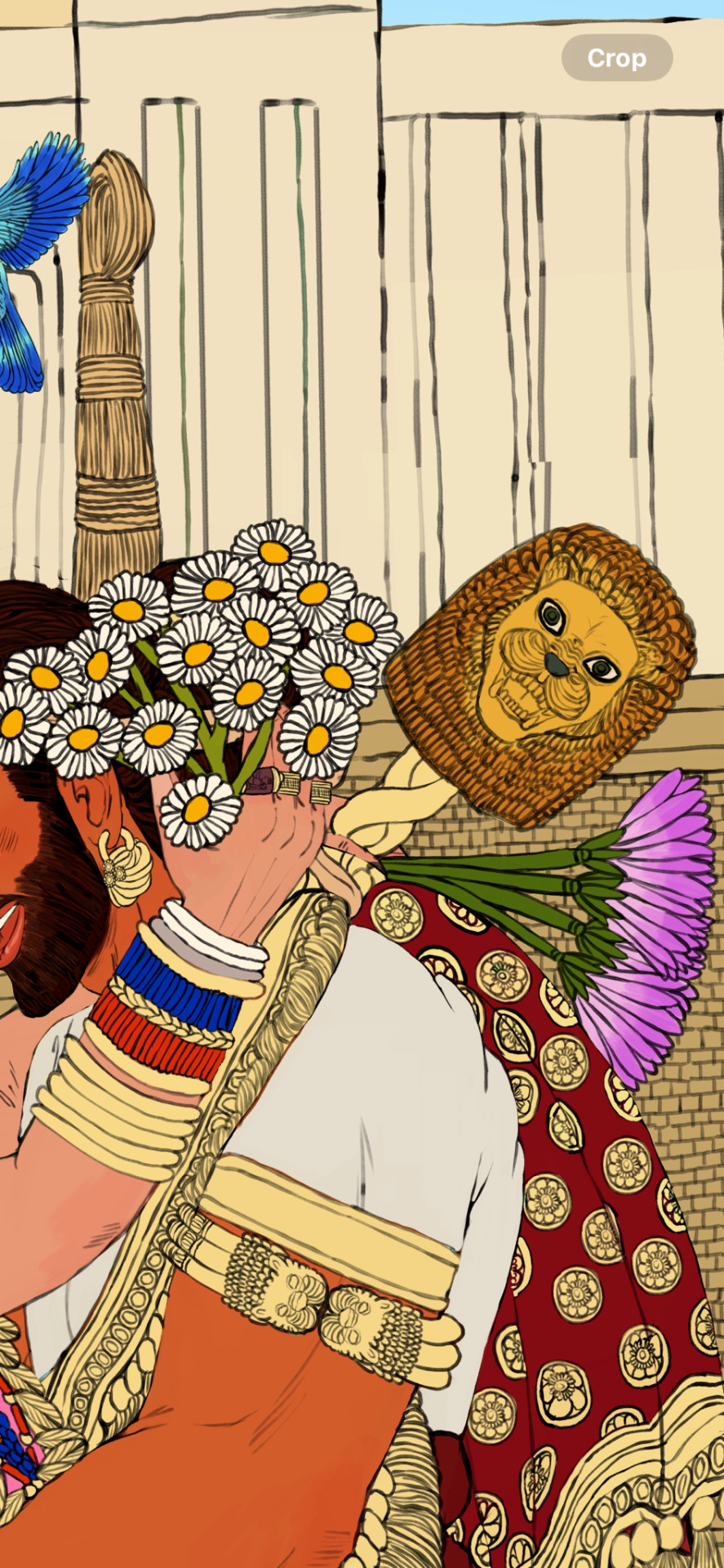
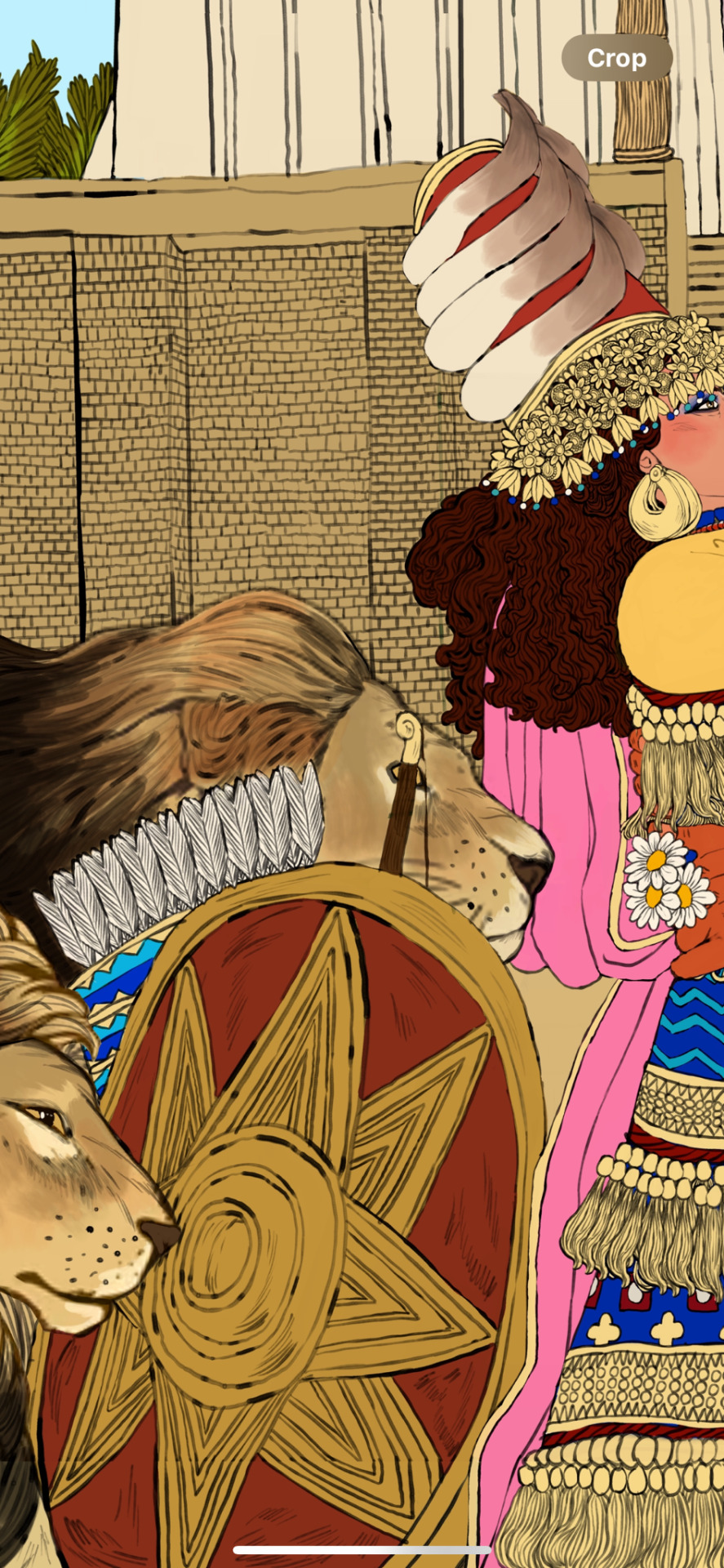
Aphrodite and Adonis in their older Mesopotamian forms; Inanna-Ishtar, the warlike goddess of beauty, fertility, and love and Dumuzi, her husband and the shepherd king of ageless Uruk.🦁🐏
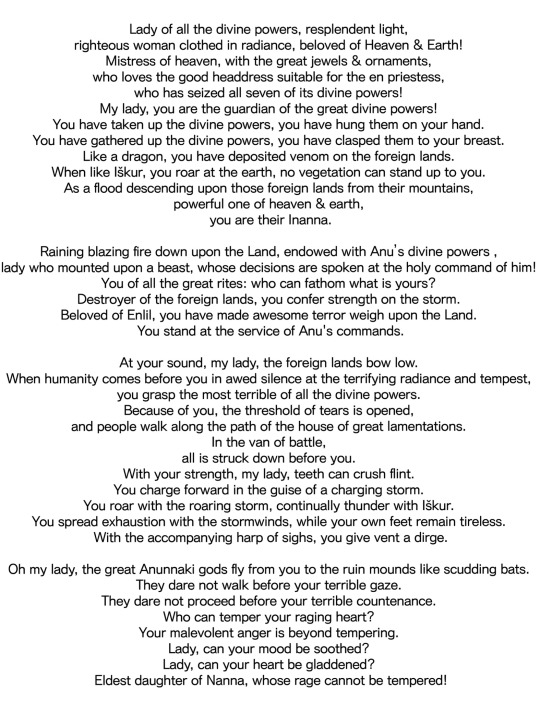
Here are the poem snippet that I used as the main inspo, written by Enhueduanna, high priestess of the moon god Nanna/Sin and daughter of King Sargon & Queen Tashlultum of Akkad. As she became a devotee of Inanna and composed various exaltation hymns to the goddess, she also composed 42 hymns addressed to many temples and sanctuaries across the land of Sumer and Akkad, the so-called Temple Hymns; which makes her become the earliest known named author in world history.
The ziggurat temple background was based on the Eanna temple (”House” of Inanna) in Uruk, which was built during the 3rd dynasty of Ur (21st cent BC) and had been mentioned throughout in the Epic of Gilgamesh; while their clothing was from later recent Assyrian & Babylonian era. All of the offerings were based on the depictions on the Warka vase from the National Museum of Iraq - an agricultural festival that seemed to be connected with the rituals involved with the goddess.
30 notes
·
View notes
Note
Literally the sanest fate fan
Naturally! After all, Inanna is the one whom Enki tells
You throw into confusion those threads which have been ordered.
You organize those threads which bring confusion
(Enki and the World Order, 435–346, tr. Bendt Alster)
and she has been argued across a few sources—most famously Harris in Inanna-Ishtar as Paradox and a Coincidence of Opposites—to be a personification of the irrational and paradoxical quiddities of existence, a mechanism through which to mediate the chaos of living and thereby restore order to the cosmos.
In my labour to offer the world glimpses of her magnificence, I am glad to see that there are those who recognise I am simply following that same ancient impulse to find sanity in a land without!
4 notes
·
View notes
Text
Satan has his candle always tall, constantly flickering and overall pretty unavoidable. I love it honestly.
Anyway, this is just some of the things going on in my practice. I have found that Inanna-Ishtar has reached out, as well as Loki. I am still researching into it all.
I still find myself drawn to Kemeticism, I had done some readings and Hathor, Ra & even Isis came by. Hathor has really made her presence known. But, my race is on the Celtic (I don’t know which part) and Mexican side, I hesitate to work with them. Especially since I hear that Kemeticism is a closed practice, sometimes I hear it’s open. I just don’t want to step on anyone��s toes & potentially disrespect someone’s culture & beliefs.
#pagan#paganism#witchblr#witchcraft#deity work#satanism#inanna#inanna-Ishtar#Ishtar#Loki#dianadeity#artemisdeity#roman pantheon#greek pantheon#kemetism#kemetic#egyptian pantheon#egyptian paganism
6 notes
·
View notes
Text
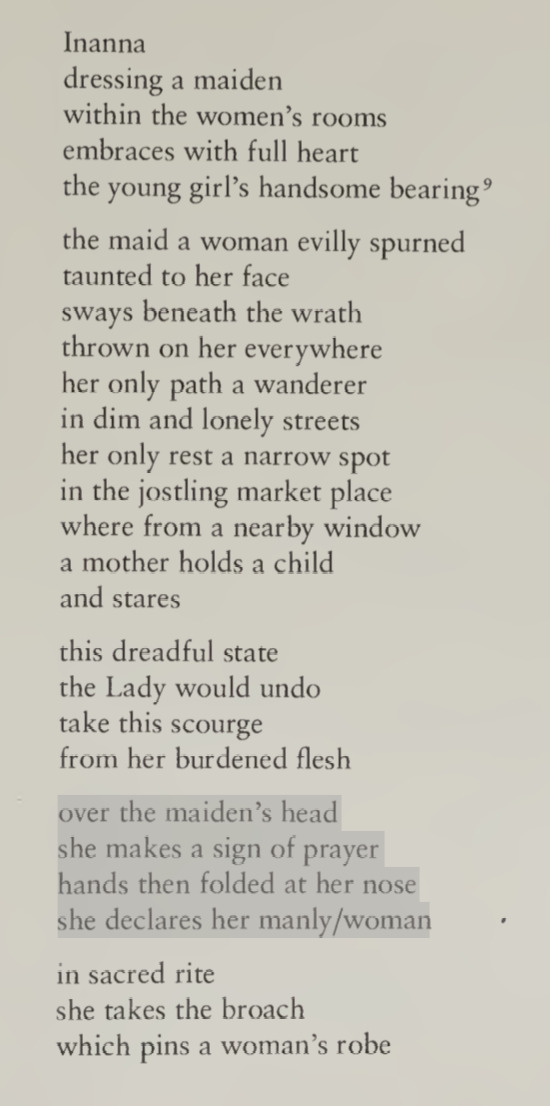
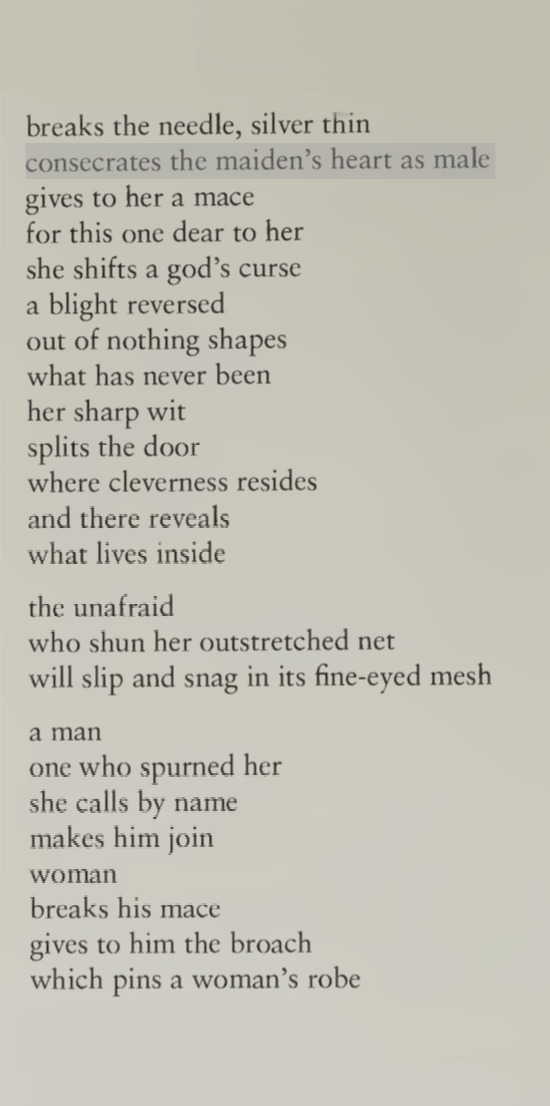

from Lady of the Largest Heart, a poem by High Priestess Enheduanna & translated by Betty De Shong Meador.
568 notes
·
View notes
Text


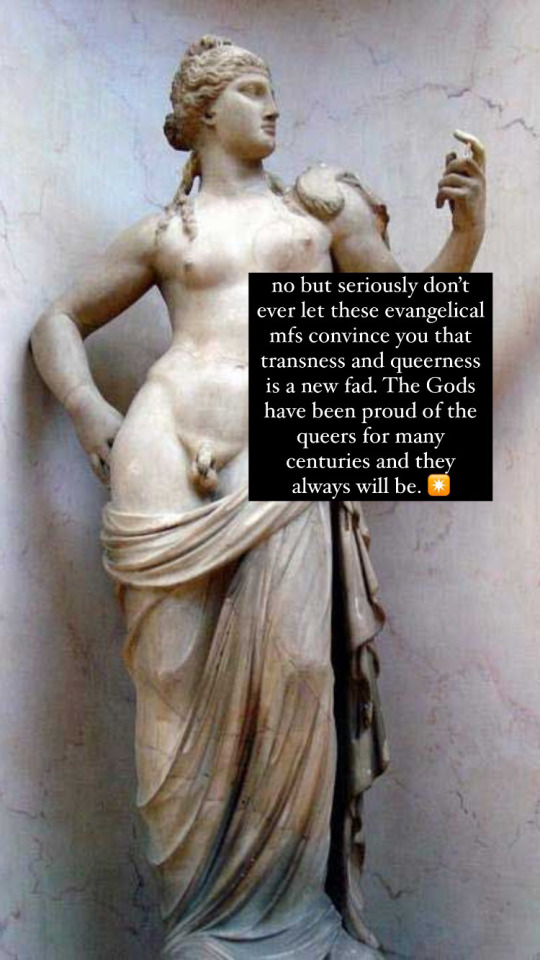
🏳️⚧️⚧🏳️🌈
#witchcraft#magick#occultism#witch community#demonology#pagan#paganism#witch aesthetic#witchblr#grimoire#paganblr#pagan witch#pagan blog#inanna#ishtar#hellenic pagan#hellenic polytheism#transgender#intersex#genderqueer#queer#queer witch#dyonisus#aphrodite#hermes deity
354 notes
·
View notes
Text

Quick drawing of Inanna in a warlike mood for pride, because with the flood of political attacks agains trans people across the world, it is closer to how I'm feeling than anything along the lines of "Happy Pride Month"
#artists on tumblr#digital art#inanna#pride month#ishtar#pride art#trans visibility#trans artwork#queer#queer art#mythologyart#sumerian#mythology
1K notes
·
View notes
Text
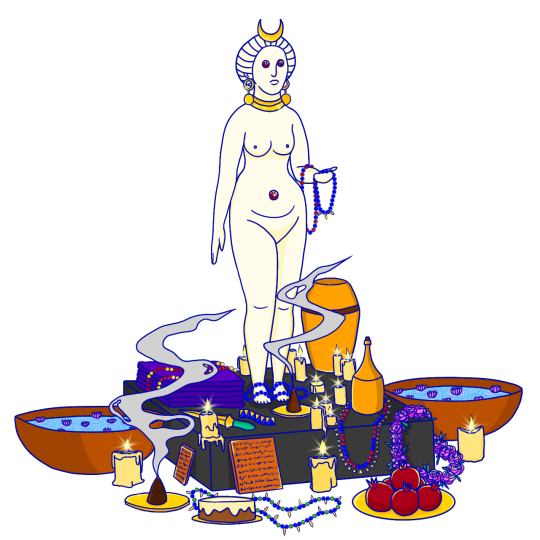
An altar to the goddess Inanna, inspired by the (much smaller) famous statue of Babylonian Ishtar. I included some items found in the royal tombs at Ur, as well.
169 notes
·
View notes
Text
The transgender and nonbinary people of ancient Sumeria
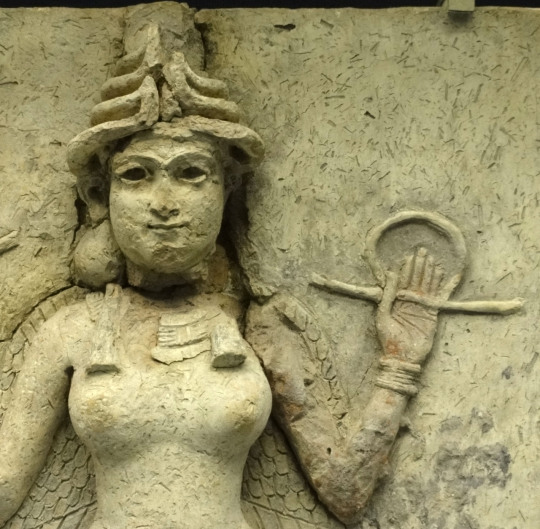
Did transgender people exist before tumblr? Transphobes seems to think transgender identities did not exist before “gender ideology”. Dr. Moudhy Al-Rashid documents the existence of ancient trans people in a thread over at twitter.
//“To turn a man into a woman and a woman into a man are yours, Inana,” reads a 4,000-year-old temple hymn to Inana, the Sumerian goddess of love and war. Non-binary gender identities are not new. Brief thread in response to that one Karen.
Link to A hymn to Inana (Inana C): translation.

Ishtar, the later Mesopotamian goddess of love and war, had gender fluid characterstics. Ashurbanipal’s hymn to Ishtar of Nineveh compares her to the god Ashur. “Like Ashur she wears a beard and is clothed with brilliance...The crown on her head gleams like the stars”

Gender fluid identity appears throughout Mesopotamian history, like that of the assinnu, a word sometimes written as a combination of the cuneiform signs for “man” and “woman”. They served as cultic personnel to Ishtar and even as prophets, like one named Šēlebum in Mari.

In Mesopotamian literature and myth, a gender fluid figure known as an assinnu named Asushunamir, helps rescue the goddess Ishtar when she becomes trapped in the Underworld.
In a Sumerian creation myth, the goddess Ninmah fashions several people out of clay. “She fashioned one with neither penis nor vagina on its body. Enki looked at the one with neither penis nor vagina on its body...and decreed its fate to stand before the king”.
Various other terms appear in cuneiform texts from ancient Mesopotamia that refer to people with non-binary gender and sex. The kalû was a singer, typically a man who participated in activities reserved for women. The pilpilû is one whose sex is “changed” by the goddess Ishtar.

In conclusion, non-binary gender identity is not new and not difficult to understand. Shame on anyone with a platform who uses it to spread misinformation and hate.//
Full thread here.
By the way, one of the clearest proofs of transgender identities in ancient Sumer and Mesopotamia, were the priestesses of Inana (or Inanna, also known as Ishtar). They are known as the Gala (referred to as kalû above). T
hey presided over religious rites, healed the sick, predicted the future, made music, raised money for the poor, and “dissolved evil” during lunar eclipses. They used feminine pronouns and dressed and lived as women. According to several sources they also castrated themselves.
The goddess of Cybele, who is closely related to Ishtar/Inanna, also had transgender priestesses called Galli. That religion became very popular in the later Roman Empire.
Top photo: Ishtar
653 notes
·
View notes
Text
Eurynome - Inanna - Ishtar - Astarte - Atargatis - Aphrodite - Venus
67 notes
·
View notes
Text
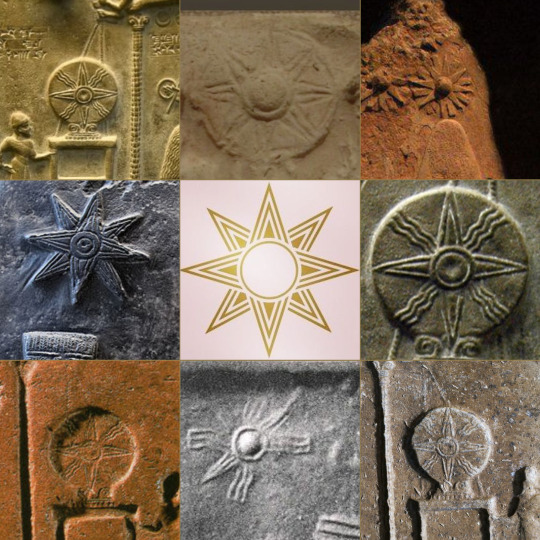
The star of Ishtar
The Octagram symbol is a star ideogram that commonly appears in ancient Babylonian iconography. The eight-pointed star is usually associated with ancient goddesses such as Ishtar, Innana, Isis and Venus. These goddesses were all seen as protectress of love, fertility, beauty, divine law and power.
The symbol was originally seen as a representation of the seven heavens ruled by the goddess and later became a representation of the planet Venus associated with fertility goddesses. The planet is the third brightest object in Earth's sky after the Sun and the Moon and in the past, it was referred to as the morning or evening star. In the Old Babylonian period, the planet Venus was known as Ninsi'anna translates to "divine lady, illumination of heaven".
In many myths, Inanna’s descend into the netherworld and return to the heavens may correspond with the movements of the planet Venus in the sky, setting in the West and then rising again in the East.
The discontinuous movements of Venus relate to both to the myth as well as Inanna's dual nature. Other theories recognize the story of Inanna's descent into the underworld as a reference to an astronomical phenomenon associated with retrograde Venus.
The symbol refers to the cosmic power of the goddess as ruler of sky and heavens and connected with the transcendental world. Her power stands in the mystery of magic and creation of the universe itself and for this reason the octagram became a powerful sigil used in antiquity as a devotional iconography connected with the goddess worshippers.
#witchcraft#witchblr#paganism#witches of tumblr#pagan witch#inanna#ishtar#octagram#venus#sacred symbols#symbolism#esoteric#sumerian#occultism#italianwitch#strega
53 notes
·
View notes
Text
𒀭𒈹, The Queen of Heaven
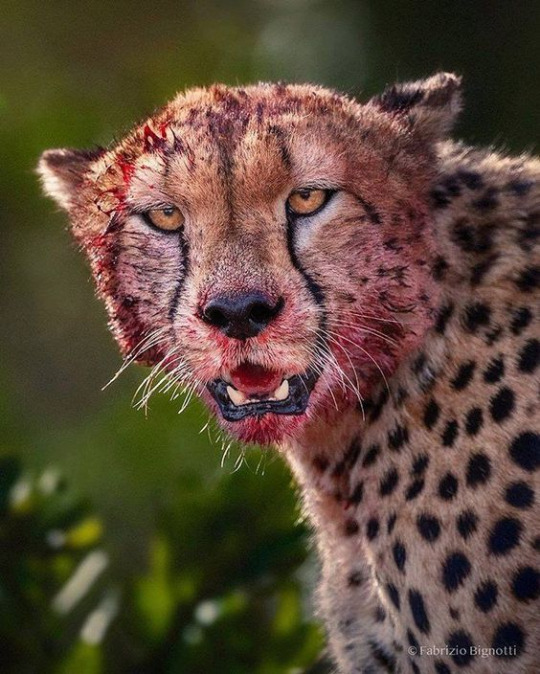

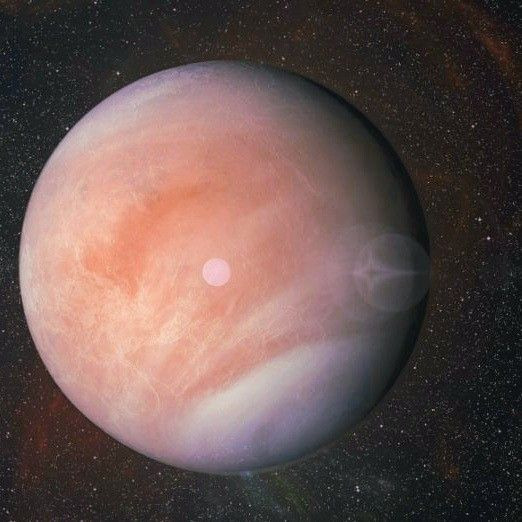



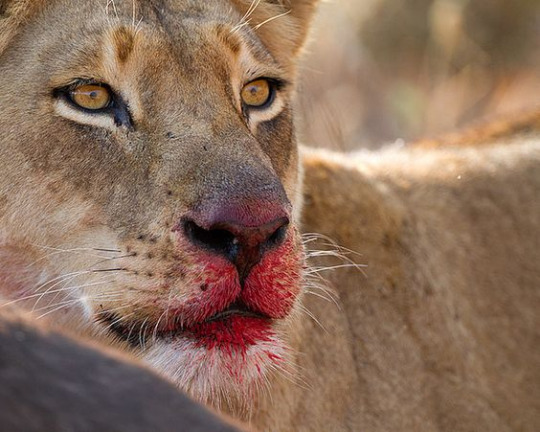
"She stirs confusion and chaos against those who are disobedient to her, speeding carnage and inciting the devastating flood, clothed in terrifying radiance. It is her game to speed conflict and battle, untiring, strapping on her sandals."
82 notes
·
View notes
Text

Ah yes, my favourite fandom —Mesopotamian mythology.
Anyway, I’m just making Gilgamesh-themed board game for my university, so now I’m spending all my time reading Samuel Kramer and listening to old Mesopotamian songs. It’s a really strange experience because while fandom is like…Dead…For centuries…
Ishtar (Inanna) and Dumuzid, my favourite hetero ship (I wanna eat pavement).
Inspired by Meat Loaf’a song “I’d do anything for love (But I won’t do that)”, it fits them soooo well.
#ancient sumeria#sumerian mythology#mesopotamian mythology#Inanna#Ishtar#Dumuzid#I’m not insane please LISTEN
94 notes
·
View notes
Text
Mythologic Geekery: Aphrodite

Alright, let me continue with Aphrodite. And she is super special. You know why? Because we know exactly where she came from, because her entire history is documented. We literally can trace her back to basically the very beginning. No comparative mythology needed
Part of the reason is, that she was just so god damn popular.
Aphrodite basically "descended" from the Phoenician Astarte. Astarte meanwhile was one of those universal goddesses. She stood for sex, beauty, healing, but also for war and hunting. She had a pretty big cult that spread into Ancient Greece, where she slowly was turned into Aphrodite.
Astarte, meanwhile, was influenced by Ishtar/Inanna from the Mesopotamian pantheon. Ishtar and Inanna are the same goddess, it is just that Ishtar was the semitic name given to her, while Inanna was the Mesopotamian and Sumarian name, with the later going back a lot further.
Inanna was associated with sex and beauty, but also with war and political power. And yes, there is some theories that Athena, too, was influenced by Ishtar as well. The semetic people also associated Ishtar as a "queen of the sky" and though already that the planet Venus represented her. So, yeah, that association goes back a long while.
Now, of course, pre-Mesopotamia we do no longer have written stuff about her. But we have enough idols found that it is pretty clear this mythologic entity was around before.
We are fairly certain, that she started out as a dawn goddess (as dawn was already something associated with Ishtar and Inanna), that hence already had the entire "beauty" thing going on, as both things were associated a lot. And because beauty and sex are kinda linked, that was picked up soon enough.
Fun fact: Rapunzel from the fairy tale? Yeah, she is probably decendent from the same dawn goddess. Just that she over time got divorced from her godly context.

#stray gods#aphrodite#venus#inanna#ishtar#astarte#rapunzel#tangled#greek gods#greek mythology#greek pantheon#mesopotamia#ancient history
109 notes
·
View notes
Text

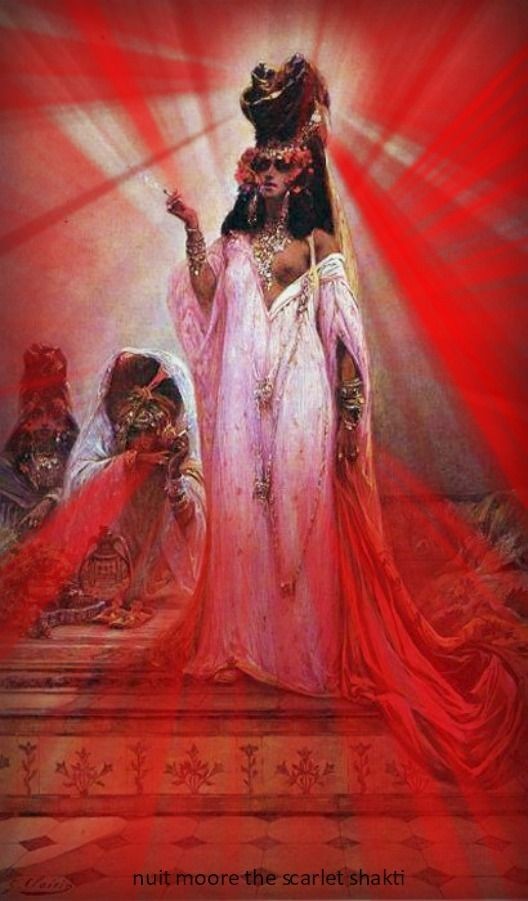
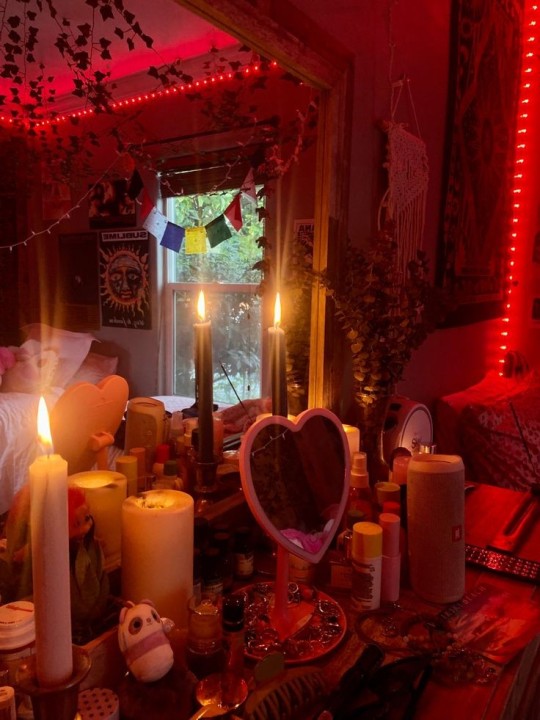

e-offering to Ishtar #002
#glamour witch#goddess of love#glamour magic#witchblr#glamour magick#ishtar#inanna#venus worship#Ishtar devotion#goddess of war
44 notes
·
View notes
Text
One of the oldest goddesses in the historical record is Inanna of Mesopotamia, who was referred to, among other honorifics, as “She who makes a woman into a man, she who makes a man into a woman.” The power to alter such fundamental categories was evidence of her divine power. Inanna was served by at least half a dozen different types of transgendered priests, and one of her festivals apparently included a public celebration in which men and women exchanged garments. The memory of a liminal third-gender status has been lost, not only in countries dominated by Christian ideology, but also in many circles dedicated to the modern revival of goddess worship. Images of the divine feminine tend to appear alone, in Dianic rites, surrounded only by other women, or the goddess is represented with a male consort, often one with horns and an erect phallus. But it is equally valid to see her as a fag hag and a tranny chaser, attended by men who have sex with other men and people who are, in modern terms, transgendered or intersexed.
— Speaking Sex to Power: The Politics of Queer Sex by Patrick Califia
#m.#ishtar#aššurism#inanna#trans spirituality#galli#trans history#paganism#trans devotees#purposefully trans#trans is divine
740 notes
·
View notes
Text


Worship a primordial Goddess of Liberation ✴️
Worship a primordial Goddess who helps you to experience pleasure to experience yourself,
who does not shame you for enjoying sex, who wants you to experience joy and love without shame or stigma- love for others as well as love for yourself.
Who’s eyes never falter, judge, or look down upon, who never discriminates, who is blind to prejudice, who never sees your desires as gross or unholy, who values your quirks and desperate habits, your urges and desires, who knows your need for love, kindness, and tenderness.
Worship a primordial Goddess who cheers for you every day, who sees you as a divine creature- a god- in yourself. Who treats you as an equal and respects you as a good friend. Who will never force you to abandon what you love or snuff your shining flame. Who will nurture you as you bloom into your most perfect self,
Worship a primordial Goddess who you were not forced to worship, but who you came to in honesty and love and chose to worship because you wanted to. Worship a primordial Goddess who will never force you to do anything, but guide you with wisdom and intuition. Who will not threaten you, but you praise you,
who will protect you viciously, and show all who wish you harm the holy wrath of a mother’s love,
who values your expression as an act of love, who admires your sexuality and gender as divine elements of the human experience.
Worship a primordial Goddess who values your orgasms, who gains joy from your satisfaction and relief, who laughs when you laugh,
who sees sex not only as a means to procreate, but to know oneself and their partner(s) in a most intimate and delicate way.
Worship a primordial Goddess who respects and understands your kinks, who understands how your body has stored your trauma and celebrates your bravery in exploring those things in a healthy and safe environment.
Worship a primordial Goddess who dances and drinks and indulges in sweets and sex, who understands that we are here to experience joy and love, who asserts that happiness and freedom are not sins, but the most powerful things we have in this world.
Worship a primordial Goddess who wants you to live and love and laugh without shame,
who wants you to live
truly live
your best most delicious life.
Worship Inanna, Give Glory to Venus. Hail the Queen of Heaven! ✴️
Happy Venus day! :)

#witchcraft#magick#occultism#witch community#demonology#pagan#paganism#witch aesthetic#witchblr#grimoire#venus#inanna#ishtar#luciferian witch#theistic luciferianism#aphrodite#deity witchcraft#deity work#deity worship#deity
132 notes
·
View notes